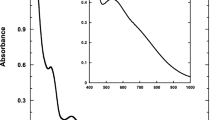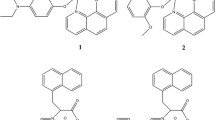Abstract
New oxovanadium(V) complexes, [VOL(hq)] (1)–(4) have been prepared by the reaction of [VO(acac)2] with ligands LH2 in the presence of 8-hydroxyquinoline (Hhq). LH2 is the dibasic tridentate ONO Mannich base [(S)-H2glysal, (S)-H2alasal, (S)-H2leusal and (S)-H2ileusal; S represents the S-enantiomer] obtained by the reduction of the Schiff bases of salicylaldehyde (sal) and the amino acids: glycine (gly), DL-alanine (ala), leucine (leu) and isoleucine (ileu), respectively. Spectral studies suggest an octahedral structure for these complexes. The complexes exhibit a single 51V-n.m.r. signal at −464.6 to −468.0 p.p.m. due to the existence of a single isomeric species in solution. In the presence of L-ascorbic acid under aerobic conditions [VO(S-glysal)(hq)] (1) and [VO(S-isoleusal)(hq)] (4) are converted into the corresponding dioxo species possible via intermediate reduction. A time- dependent 51V-n.m.r. study has also been carried out in order to investigate the possible isomerisation and/or further reaction in solution.
Similar content being viewed by others
References
K.H. Thompson, J.H. McNeill and C. Orvig, Chem. Rev., 99, 2561 (1999).
A. Butler, M.J. Clague and G.E. Meister, Chem. Rev., 94, 625 (1994).
D. Rehder, in A.X. Trautwein (Ed.) Bioinorganic Chemistry: Transition Metals in Biology and their Coordination Chemistry, Wiley, Weinheim, 1997, Chap. D6.
E.J. Baran, J. Inorg. Biochem., 80, 1 (2000).
T. Kiss, T. Jakush, M. Kilyen, E. Kiss and A. Lakatos, Polyhedron 19, 2389 (2000).
D. Rehder, Coord. Chem. Rev., 182, 297 (1999).
I. Cavaco, J.C. Pessoa, M.T. Duarte, R.T. Henriques, P.M. Matias and R.D. Gillard, J. Chem. Soc., Dalton Trans., 1989 (1989).
R. Fulwood, H. Schmidt and D. Rehder, J. Chem. Soc., Dalton Trans., 1443 (1995).
S. Mondal, S. Dutta and A. Chakravorty, J. Chem. Soc., Dalton Trans., 1115 (1995).
S. Mondal, S.P. Rath, K.K. Rajak and A. Chakravorty, Inorg. Chem., 37, 1713 (1998).
K.K. Rajak, S.P. Rath, S. Mondal and A. Chakravorty, Inorg. Chem., 38, 3283 (1999).
V. Vergopoulos, W. Priebsch, M. Fritzsche and D. Rehder, Inorg. Chem., 32, 1844 (1993).
L.L. Koh, J.O. Ranford, W.T. Robinson, J.O. Svensson, A.L.C. Tan and D. Wu, Inorg. Chem., 35, 6466 (1996).
(a) P. Patel and P.K. Bhattacharya, Ind. J. Chem., 32A, 506 (1993); (b) C.A. Sureshan and P.K. Bhattacharya, J. Chem. Res. (M), 2186 (1998).
R.A. Rowe and M.M. Jones, Inorg. Synth., 5, 113 (1957).
D. Rehder, C. Schulzke, H. Dau, C. Meinke, J. Hanss and M. Epple, J. Inorg. Biochem., 80, 115 (2000).
C.J. Carrano and J.A. Bonadies, J. Am. Chem. Soc., 108, 4088 (1986).
D. Rehder, C. Weidemann, A. Duch and W. Priebsch, Inorg. Chem., 27, 584 (1988).
D. Rehder, in P.S. Pregosin (Ed.) Transition Metal Nuclear Magnetic Resonance, Elsevier, New York, 1991, p. 1.
M.R. Maurya, S. Khurana, C. Schulzke and D. Rehder, Eur. J. Inorg. Chem., 779 (2001).
G. Asgedom, A. Sreedhara and C.P. Rao, Polydehron, 14, 1873 (1995).
Author information
Authors and Affiliations
Rights and permissions
About this article
Cite this article
Maurya, M.R., Khurana, S. & Rehder, D. Six-coordinated oxovanadium(V) complexes of reduced Schiff bases derived from amino acids: synthesis, reactivity and redox studies. Transition Metal Chemistry 28, 511–517 (2003). https://doi.org/10.1023/A:1025016603173
Issue Date:
DOI: https://doi.org/10.1023/A:1025016603173




